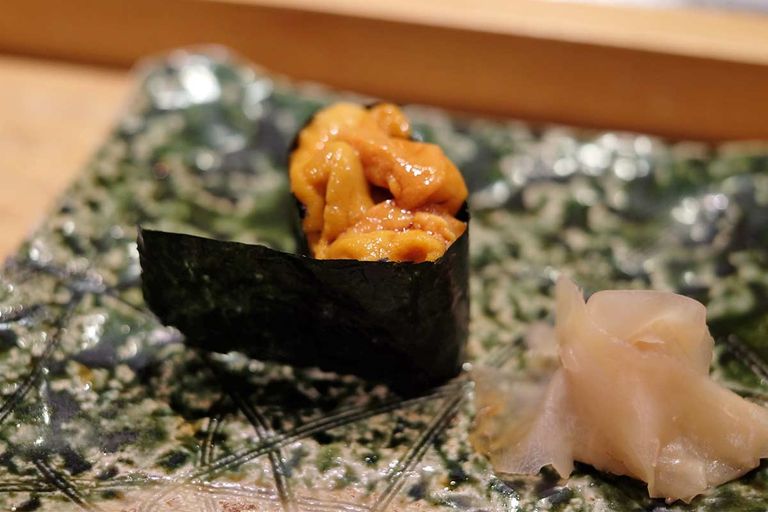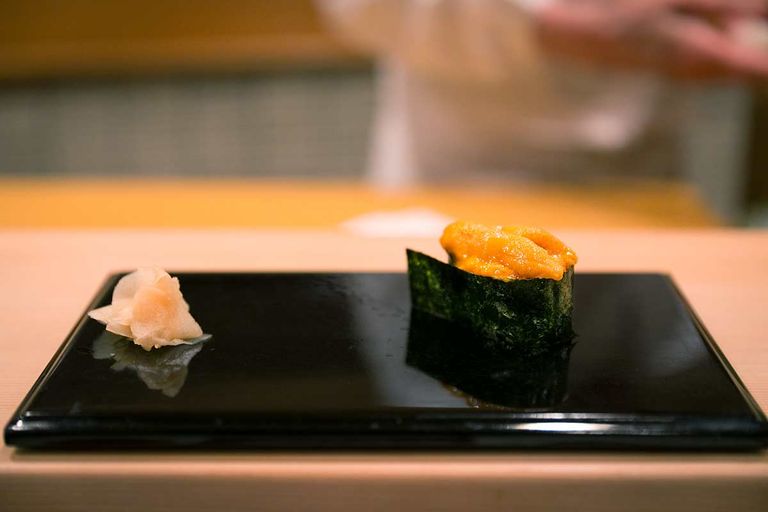Uni Sushi
A Comprehensive Overview of Sea Urchin in Japanese Sushi Cuisine
ウニすし 、 海胆(海栗・雲丹)寿司 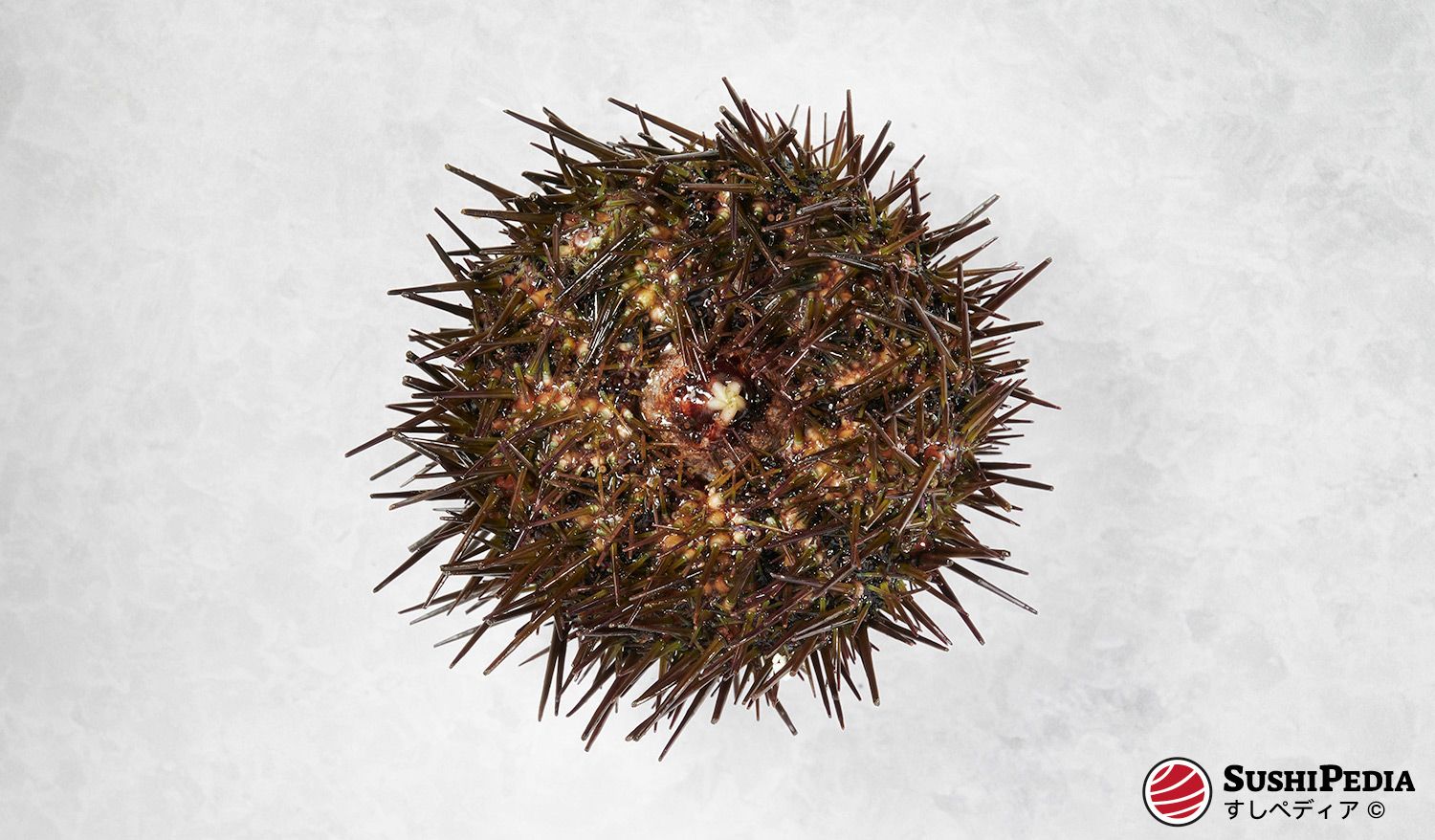
What is Uni?
In a culinary context, the Japanese word uni ウニ refers to the gonads of the sea urchin, a highly prized delicacy from the echinoderm group. The gonads of the sea urchin are the sexual organs in which sex hormones and germ cells are produced. These gonads produce either eggs or sperm, depending on the sex of the animal. The term uni is also used synonymously for the animal itself. There are up to a thousand species worldwide,[1] but only a small proportion of these are used as food. Around 80 species of sea urchin are poisonous to humans.[2] The gonads of the sea urchin, often mistakenly referred to as roe, are considered a delicacy in Japan and many other regions of the world. In Japan, they are one of the most popular sushi ingredients.
Uni for Sushi or Sashimi
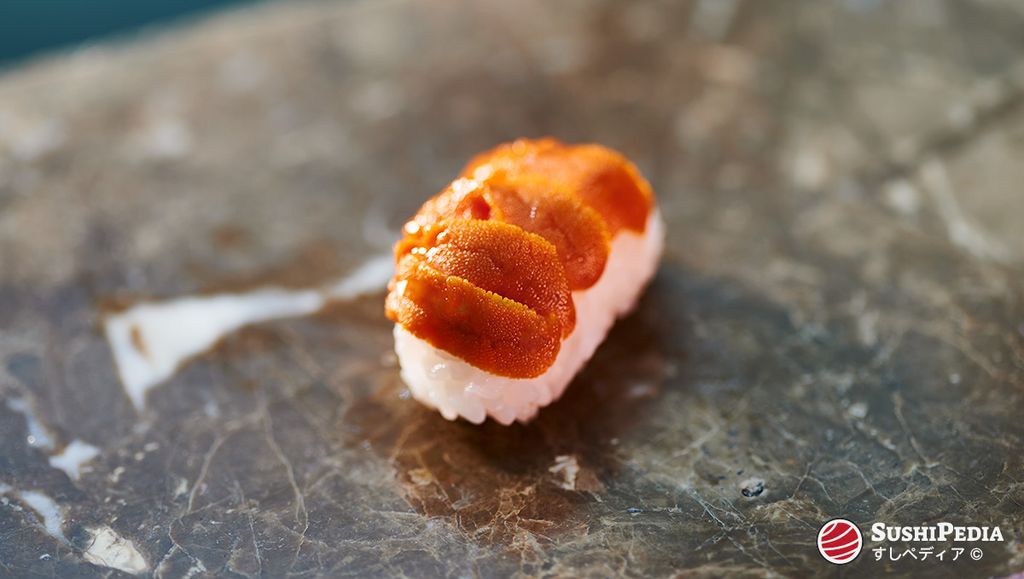
SushiPedia. Uni Nigiri Sushi. All rights reserved ©
The raw gonads of the uni have an unmistakable taste. The exceptionally full-bodied umami taste is accompanied by mineral, sweet and slightly salty aromas reminiscent of the sea. The texture is extremely soft and literally melts on the tongue. Although uni can be eaten wonderfully on its own, it also tastes very well in combination with normal or vinegared rice. The most important factor for the good taste is freshness. Fresh uni has a pleasant and hardly noticeable odor. However, if stored too long or incorrectly, it has an unappetizing fishy smell and taste. For this reason, cheap, industrially processed or uni intended for export is enriched with alcohol or other preservatives (e.g., alum), which also have a negative effect on the taste. Another significant factor is the nutrition of the sea urchins, as this influences the taste and the size of the gonads. Since the main component of their diet consists of seaweed, it is obvious that tasty sea urchins are mainly found in regions known for their seaweed quality.[3][4]
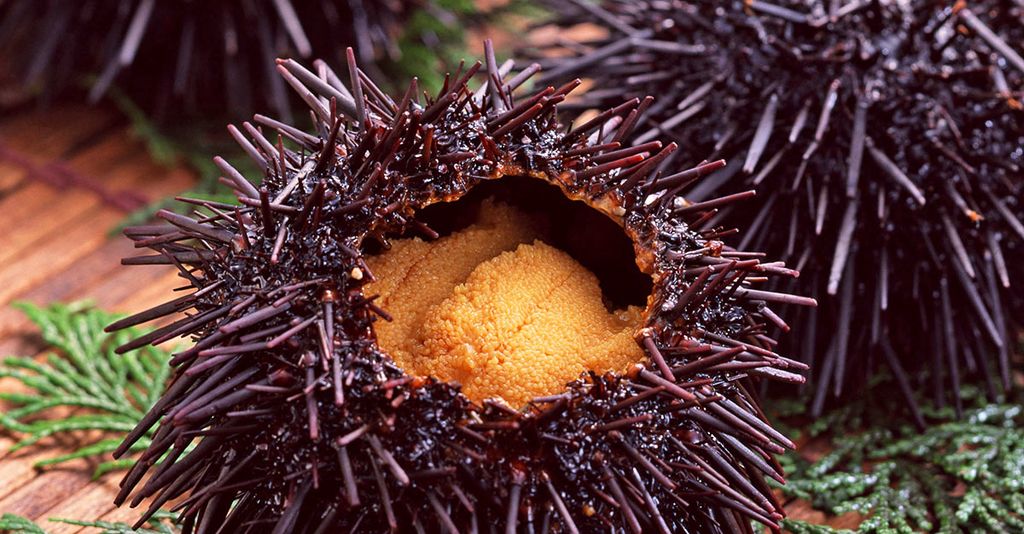
Non-disclosed author. All rights reserved ©
As Sushi, uni is prepared either as gunkanmaki sushi or nigiri sushi. Although it is a high-priced ingredient, it is today part of the standard repertoire in many sushi restaurants. The combination of uni and ika is popular, either as a side dish or by placing uni in small quantities on the ika meat. Ikura, the fish roe of the salmon, is also a popular side dish, which is called uni ikura kaisen don.
Best Season

SushiPedia. Uni Gunkan Maki. All rights reserved ©
The best time of year for uni depends very much on the species and region. Sea urchins have different breeding seasons depending on the region, even if they are the same species. The fishing season in the Sea of Japan lasts from June to August and shifts towards the Pacific and Sea of Okhotsk. In Hokkaidō, the season for eating sea urchins is from January to June, on the Shiretoko Peninsula and from June to August on the Shakotan Peninsula and in Otaru. All the preferred species in Japan vary considerably throughout the year, so that good quality uni is available over a long period of time. Sea urchins caught along the coasts of Europe, the United States and Canada are particularly tasty during the winter months.[5] Uni caught out of season tastes bitter and unappetizing. The edible portion per individual is about 2 grams. The bitter pulcherrimin decreases after spawning and increases with maturity.[6] Therefore, shortly before and during the spawning period, some individuals, especially the ovaries of females, are very bitter and not suitable for consumption. After the spawning period, the gonads shrink. Subsequently, the gonads are filled with nutrient cells and enlarge. This time is considered the best for consumption.
Traditional and Industrial Processing of Uni: Methods and Conservation
When uni is processed, it is usually broken open, cleaned and sorted before being arranged in the sales packaging. To increase the shelf life, industrial preservatives are often added to the removed gonads. In traditional processing, however, the gonads are cleaned and then preserved in salt water. This water has approximately the same salt content as the seawater of the region from which the gonads originate. This method is called ensui 塩水 or shiomizu しおみず, which literally means “sea urchin in salt water”. It is said that this “natural” preservation method preserves the original taste better.
Types of Uni
Several species of sea urchin are both economically important and common in Japan. Among the most important are bafun-uni, which is prized for its rich flavor and gonads that range from yellow to orange. Ezo-bafun-uni is a species of sea urchin found mainly in the colder waters around Hokkaidō. The term ezo 蝦夷 was historically used to refer to the area of Hokkaidō and the northern regions of Japan before they were fully integrated into the Japanese Empire. Ezo-bafun-uni is known for its intensely colored gonads, ranging from orange to deep red, and is prized for its rich, sweet flavor. Murasaki-uni has a longer harvest period and is particularly common on the Pacific coast of Japan. Another significant species is the aka-uni, whose gonads are often bright orange to red in color. The kita-murasaki-uni is particularly common in the northern regions, especially in Hokkaidō. It is the most commonly harvested edible sea urchin in Japan, accounting for about 44% of the total commercial harvest,[7] followed by ezo-bafun-uni. These sea urchin species play a significant role in the Japanese fishing industry and are caught both for the domestic market and for export.[8]
Ezo-Bafun-Uni
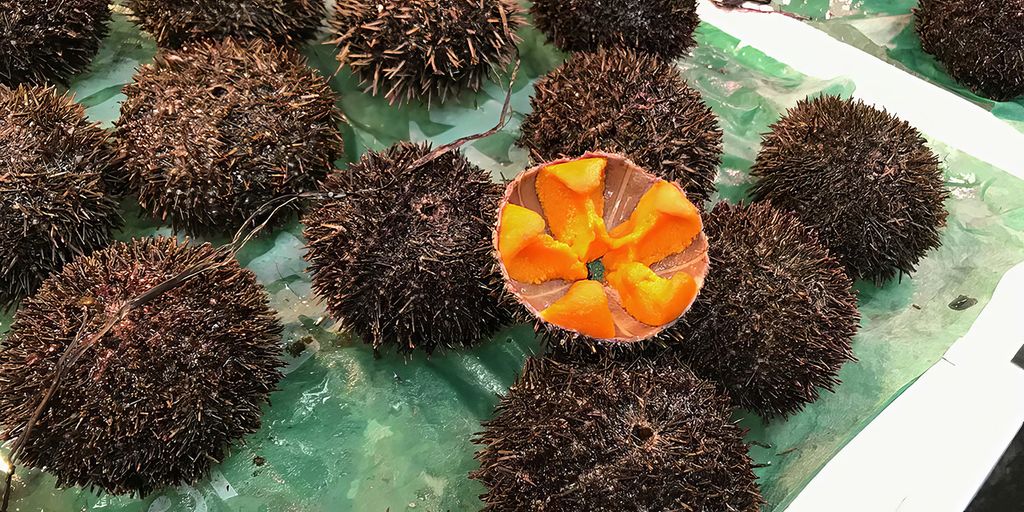
SushiPedia. Bafun Uni Sea Urchin Gonads. All rights reserved ©
Ezo-bafun-uni is a species of sea urchin found mainly in the colder waters around Hokkaidō. The term ezo 蝦夷 was historically used to refer to the area around Hokkaidō and the northern regions of Japan before they were fully integrated into the Japanese Empire. The term therefore refers to the area where ezo-bafun-uni is traditionally fished in Japan. In Japanese, the word bafun 馬糞 means “fecal ball of a horse” and metaphorically refers to the appearance of this species of sea urchin. Although they do not scientifically belong to the “bafun-genus” (lat. Hemicentrotus), they are so visually similar to them that they traditionally bear their name. The ezo-bafun-uni is known for its intensely orange to deep red colored gonads and is prized for its rich, sweet taste. This species plays an important role in the Japanese fishing industry and is harvested both for the domestic market and for export.
Kita-Murasaki-Uni
Kita-murasaki-uni is a species of sea urchin that is particularly common in the northern regions of Japan, especially in Hokkaidō. The name kita-murasaki 北紫 literally means “northern purple”, with murasaki 紫 referring to the purple color of the spines of this sea urchin species. The term kita 北 refers to the northern distribution of this species. Although the kita-murasaki-uni does not scientifically belong to the same genus as the murasaki-uni, it resembles it in appearance and taste. This species is known for its high-quality gonads, which range from yellow to orange and have a rich, sweet flavor. Kita-murasaki-uni caught on the coasts of Oma, in Aomori Prefecture, are considered a special delicacy in Japan and are traded at high prices. It plays an important role in the Japanese fishing industry. It is the most widely caught species of sea urchin in Japan.[9] Furthermore, it is caught both for the Japanese market and for international export.
Uni in Japan
The characters 雲丹 for uni are used to indicate the food produced from the gonads of the sea urchin. Translated, they are understood as “vermilion cloud” and describe as a metaphor the appearance of the food. The animal itself is described either with the signs 海胆, which can be interpreted as “innards of the sea”, or with 海栗, which can be translated as “sea chestnut” and indicates the external similarity.
The largest market for seafood and sea urchins is the Toyosu market in Tokyo, nowhere else is uni traded on a comparable scale. Every day, the daily price is determined at the uni auction, called uni no seri. Besides tuna, uni is one of the few products whose price is still determined by auction nowadays. The auction is not a classical auction as it is usually known, in which the bidders bid in ascending order until no more bids are received, instead it is a variant in which each bidder makes only one bid. The contract is then granted to the bidder with the highest bid. The expected price ranges are wide, so uni in low quality is available from ¥400, while premium quality can reach ¥10,000 and more. As of May 16, 2024, ¥400 is equivalent to ≈ $2.6 and ¥10,000 is equivalent to ≈ $65. Uni is divided into three categories labeled A, B and C respectively. For the preparation of sushi, only the top two levels A and B are used. A distinction is also made between color-coded and sorted uni (narabi) and various colored, unordered (bara) packages.
Ichigo-ni: Aomori’s ‘Strawberry Soup’ with Sea Urchin and Abalone
Ichigo-ni いちご煮 is a traditional dish from Aomori Prefecture in northern Japan. The name literally means “strawberry soup”, although the dish does not contain strawberries. Instead, it is a clear soup made from fresh sea urchin and abalone. The ingredients are gently cooked in a dashi broth and refined with a touch of soy sauce and sake. The name “strawberry soup” is derived from the pink color of the sea urchin, which is reminiscent of strawberries. This dish is known for its delicate but intense taste of the sea and is often served on festive occasions and special occasions.
Uni no Kaiyaki: Sea Urchin Baked in Clamshells
A traditional dish from Aomori Prefecture is uni no kaiyaki ウニの貝焼き, which literally means “sea urchin baked in clamshell”. To prepare this dish, fresh sea urchin gonads are placed in large clamshells and doused with a mixture of sake, soy sauce and sometimes egg. The mussels are then heated on a grill or an open flame until the uni is lightly browned and cooked through. The result is a delicate, rich dish that retains the intense flavor of the sea urchin and is enhanced by the addition of sake and soy sauce. Uni no kaiyaki is often served at celebrations and special occasions.
Characteristics & Ecology of Uni

SushiPedia. Different Colors of Sea Urchins. All rights reserved ©
Sea urchins, which belong to the class of echinoderms (Echinoidea), exhibit a number of remarkable ecological and biological characteristics that allow them to thrive in a variety of marine environments. These radially symmetrical creatures are characterized by their spiny exterior, which serves both as a protective barrier and as a means of locomotion, aided by tube feet. The typical habitat of sea urchins encompasses a range of environments, from the intertidal zone to the deep sea, including rocky, sandy, and seagrass habitats.
Their range extends across all oceans and climatic zones, and they colonize rocky coasts right down to the bottom of the deep sea. Their diet consists primarily of algae, but there are also species that feed on carrion, microorganisms or marine snow. Their natural predators mainly include sea otters and starfish. The structural features of sea urchins, including their calcareous endoskeleton, which consists of numerous plates and movable spines, are crucial for their defense and interaction with their environment. These features not only protect them from predators, but also help them burrow and navigate through complex terrain. Some species of sea urchins are exceptionally long-lived, for example, studies have shown that individuals of red sea urchin can live up to 200 years.[10]
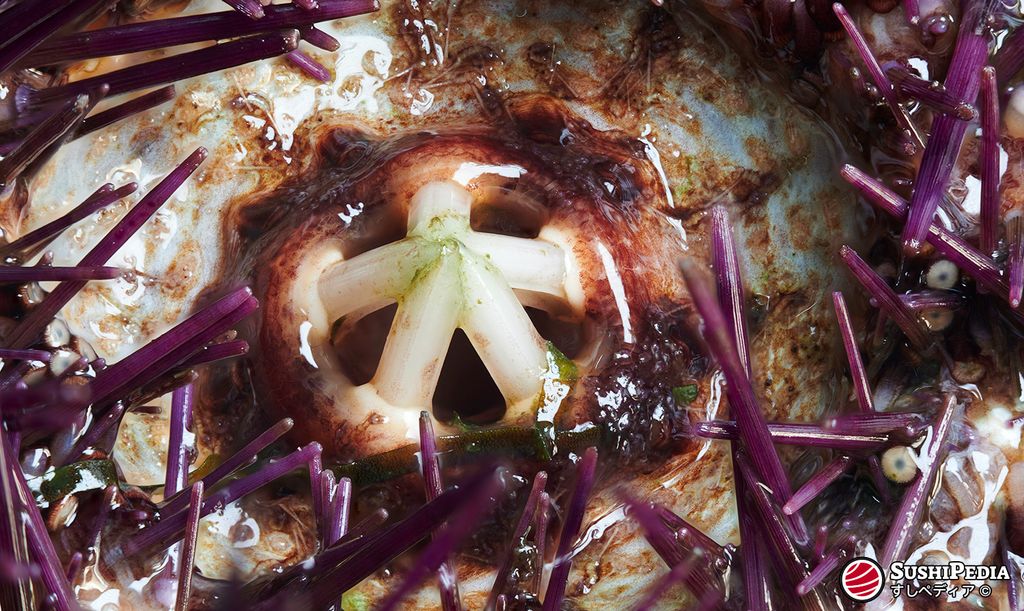
SushiPedia. Mouth of a Sea Urchin. All rights reserved ©
Ecologically, sea urchins play a central role in their ecosystems. They are known both as herbivores, feeding mainly on algae, and as omnivores, consuming detritus (dead organic matter) and other organic matter. This diet helps to control algae populations and prevent overgrowth, which can be harmful to coral reefs. However, in the absence of natural predators such as sea otters and certain fish species, sea urchin populations can grow uncontrollably, leading to overgrazing. This phenomenon, known as “urchin barrens”, is characterised by the absence of significant algal life in large areas.
Economy of Uni
Most sea urchins traded on the Japanese market are ezo-bafun-uni and kita-murasaki-uni. In Europe, the stone- and European edible sea urchin is the most common species. In the United States, sea urchins are most commonly served in Japanese sushi restaurants, where mainly purple-, red-, green sea urchins and species imported from Japan are used.
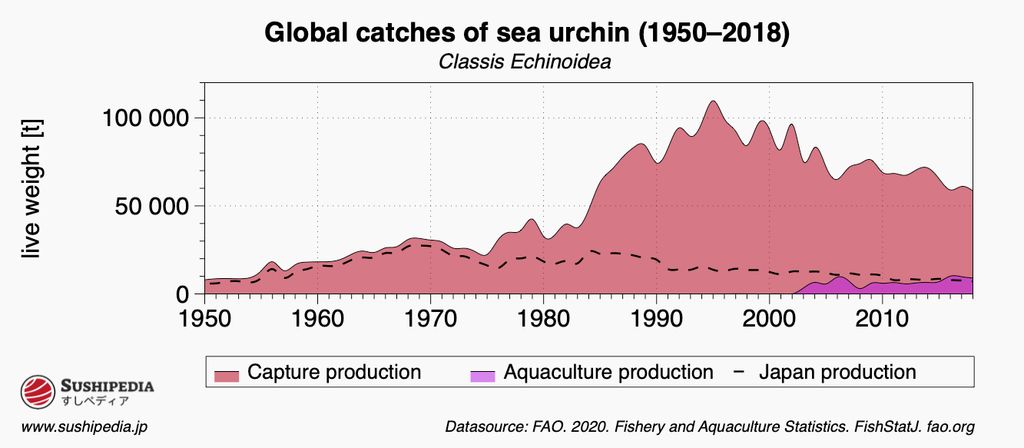
SushiPedia. Global Sea Urchin Harvest (1950–2018). All rights reserved ©
Season Calendar for Uni
The calendar shown does not provide information on fishing times, but marks the periods in which uni is considered particularly tasty.
Video about Uni Sushi
External video embedded from: youTube.com. Credit SUSHI LABO. ウニ(バフンウニ)の握り【寿司の握り方】.
Species of Uni
The following species are regarded as authentic uni. Either historically, according to the area of distribution or according to the common practice in today's gastronomy: The term uni encompasses a variety of species that are grouped together under these names. Due to the extensive diversity of these species, it is not always possible to list all specific taxa in this list completely.
0
0
In the following, those species are listed that can be considered as substitutes for authentic species with regard to uni. This can be based either on their genetic relationship or on their similarity in taste and appearance. The selection is subjective and is not strictly based on Japanese conventions, but also takes into account the practices in the respective areas where the Japanese dishes are prepared. This flexible approach allows for adaptation to local availability and preferences while preserving the core flavor and texture traditionally associated with uni.
Sources and Further Reading
- [1]Nicolás Mongiardino Koch, Simon E. Coppard, Harilaos A. Lessios, Derek E. G. Briggs, Rich Mooi & Greg W. Rouse. A phylogenomic resolution of the sea urchin tree of life. BMC Evolutionary Biology 18 189. 2018. DOI: 10.1186/s12862-018-1300-4.
- [2]André Luiz RossettoI, Jamesson de Macedo MoraII, Vidal Haddad Junior. Sea urchin granuloma. Case Report. Rev. Inst. Med. trop. S. Paulo 48 (5). 2006. DOI: 10.1590/S0036-46652006000500013.
- [3]Satomi Takagi, Yuko Murata, Eri Inomata, Hikaru Endo, Masakazu N. Aokia, Yukio Agatsuma. Improvement of gonad quality of the sea urchin Mesocentrotus nudus fed the kelp Saccharina japonica during offshore cage culture. Aquaculture 477 50-61. 2017
- [4]Satomi Takagi, Yuko Murata, Eri Inomata, Masakazu N. Aoki, Yukio Agatsuma. Pronounced effects of the basal frond portion of the kelp Saccharina japonica on gonad qualities of the sea urchin Mesocentrotus nudus from a barren. 516. 2020
- [5]Meredith Lopuch. Seafood Watch Seafood Report, Red Sea Urchin Strongylocentrotus franciscanus, Green Sea Urchin Strongylocentrotus droebachiensis. Monterey Bay Aquarium, Monterey. 2008. Source retrieved 12/27/2020
- [6]村田 裕子, 山本 達也, 金庭 正樹, 桑原 隆治, 横山 雅仁. 『バフンウニ生殖腺の苦味の発現頻度』. 日本水産学会誌 64 (3) 477-478. 1997. DOI: 10.2331/suisan.64.477.
- [7]Yukio Agatsuma. Ecology of Strongylocentrotus nudus. Developments in Aquaculture and Fisheries Science 32 347-361. DOI: 10.1016/S0167-9309(01)80021-1.
- [8]横浜・野毛の寿司屋 錦寿司 ≪ うにの豆知識 ≫ (Nishiki-zushi, a sushi restaurant in Noge, Yokohama << Knowledge of sea urchin >>). 錦寿司. Source retrieved 1/6/2022
- [9]田中颯、 大作晃一、 幸塚久典. 『ウニ ハンドブック』. 文一総合出版、2019年10月29日
- [10]Thomas A. Ebert, John R Southon. Red sea urchins (Strongylocentrotus franciscanus) can live over 100 years: confirmation with A-bomb 14carbon. Fishery Bulletin 101 (4) 915–922. 2003
- [11]Louis W. Botsford, Alan Campbell, Robert Miller. Biological reference points in the management of North American sea urchin fisheries. Canadian Journal of Fisheries and Aquatic Sciences 61 (8). 2004
- [12]Laura Rogers-Benett. Edible Sea Urchins: Biology and Ecology: The Ecology of Strongylocentrotus franciscanus and Strongylocentrotus purpuratus. Elsevier, Amsterdam. 2007
- [13]John M. Lawrence, A.L. Lawrence, S.C. McBride, Sophie B George. Developments in the use of prepared feeds in sea-urchin aquaculture. World Aquaculture. 2001
- Atsuko Hashimoto, David J. Telfer. Food and Wine Festivals and Events Around the World, Ch: From saké to sea urchin: Food and drink festivals and regional identity in Japan. Routledge, London. 2008
- John M. Lawrence. Edible Sea Urchins: Biology and Ecology, Sea Urchin Roe Cuisine, Developments in Aquaculture and Fisheries Science, Vol. 37. Elsevier Science, Amsterdam. 2001
- Kenichi Tajimaa, John M. Lawrence. Edible Sea Urchins: Biology and Ecology: Disease in edible sea urchins. Developments in Aquaculture and Fisheries Science 32 139-148. 2001
- Piero Addis, Davide Moccia, Marco Secci. Effect of two different habitats on spine and gonad colour in the purple sea urchin Paracentrotus lividus. DOI: 10.1111/maec.12133.
- IUCN Red List of Threatened Species. Version 2023-1
Image Credits
- SushiPedia. Global Sea Urchin Harvest (1950–2018). All rights reserved ©
- Jun Seita. 雲丹 Fujifilm X-T1. flickr.com. Some rights reserved: Attribution 2.0 Generic (CC BY 2.0)
- Unknown author. Top view of a sea urchin. All rights reserved ©
- SushiPedia. Bafun Uni Sea Urchin Gonads. All rights reserved ©
- SushiPedia. Mouth of a Sea Urchin. All rights reserved ©
- SushiPedia. Uni Nigiri Sushi. All rights reserved ©
- Non-disclosed author. All rights reserved ©
- SushiPedia. Different Colors of Sea Urchins. All rights reserved ©
- City Foodsters (Grace Chen, Jason Wang). Uni (sea urchin), Sukiyabashi Jiro, Tokyo, JP. flickr.com. Some rights reserved: Attribution 2.0 Generic (CC BY 2.0)
- SushiPedia. Uni Gunkan Maki. All rights reserved ©
